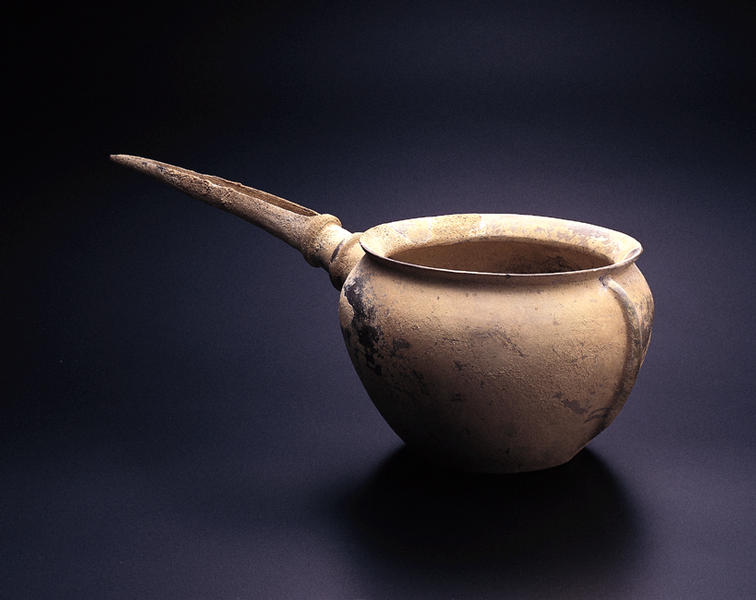嘴形注口容器
- イラン北部/北東部
- 紀元前2千年紀後期-紀元前1千年紀初期
- 陶器
- H-16.2 D-21 W-52
土器の胎土、器形、磨研した表面からこの作品は、前2千年紀の後半から1千年紀の初期にかけて土器と金属器の間に相互影響が顕著であった、北または北西イランで制作されたものであることがわかる。長い嘴形注口は壊れやすいことから考えると、この容器は日用品というよりも儀式用として用いられていたであろう。把手が無いから、このような容器は使用者が両手で抱き抱え、注意深く液体を注いだにちがいない。長い注口から注がれる液体は見応えのある大きな弧を描いて流れる。手のこんだ儀式に適切な容器である。同種の容器や他の精巧な注口付き容器が墓の中から発見されている。液体(水、葡萄酒など)を注ぐ潅奠(かんてん)の儀式を含む葬送儀礼が行われたと思われる。器形の優雅さ、類品が少なさからみて、高位の人のために名匠が制作したと思われる。
ライベイション
メソポタミアには潅奠(ライベイション)という液体を注ぐ宗教的儀礼が古くからありますが、井戸の冷水、聖水が神々に捧げられました。
南メソポタミアのバビロニアでは、死者に対する潅奠は水のみが使われたようです。更に、メソポタミアの神話には「生命の水」を捧げる話が見られます。
また神々には酒が捧げられる事も多く、ミルク、蜂蜜、油あるいはクリームが伴う事もありました。
灌奠にあたって、液体は祭主のまわりの地面に杯、椀、瓶などから注がれましたが、その器はしばしば金銀など高価な材質でつくられました。
あるいは犠牲の羊の頭、川、泉、または第二の器や門戸などにも注がれました。
猛禽装飾杯
人物文様杯
猛禽文様杯
牡牛装飾脚杯
注口付土器について
メソポタミアには潅奠(かんてん/ライベイション)という液体を注ぐ宗教的儀礼が古くからありますが、井戸の冷水、聖水が神々に捧げられました。
南メソポタミアのバビロニアでは、死者に対する潅奠は水のみが使われたようです。更に、メソポタミアの神話には「生命の水」を捧げる話が見られます。
死者に対しての灌奠は地中に差し込まれた粘土製の管に注がれました。
マルリク周辺、北イランからは長い注口のついた青銅器が出土していますが、これを陶器に写した黒色ないし黒褐色の注口付土器が同地域から見つかっています。
ここに見られる、紀元前1000年頃と思われる器の長い注口は、長い管の上部を先端に向けて削り、細長い開口部が作られています。還元焔で焼成したためか黒色を帯びていますが、注口に環状装飾を巡らし、表面を研磨するなど金属器に似せる工夫がなされています。
おそらくこの器に特有な長い半管状の注口は、この地中の死者に対し延べられた管に水を注ぐためのものであったと想像されます。
この種の器は獣足の台にのせられて使用されましたが、この注口の反対側には縦に伸びた凸帯が見られ、北イランから出土したほぼ同時代と考えられる注口付の形象土器との関連から類推して、何らかこれらの儀器に表された動物の尻尾を表現したものではないかと思われます。
Catalogue Entry
This spouted bowl has a high, rounded shoulder, a wide mouth with a narrow, sharply everted rim, and a flat base. A long beak-spout with a cylindrical section juts horizontally from the shoulder and tapers to a pointed tip. Two thick round bands encircle the spout, the second band marking the beginning of the long open trough of the spout. A rounded rib-like flange tapers from the neck to the base opposite the spout. The fine dense ceramic fabric has a dark burnished surface, giving the vessel a metallic appearance. The influence of metal vessels on ceramics (skeuomorphism) is also seen in the thin rim of the neck, the sharp angle at which it joins the body, and the round bands or ribs near the base of the spout. It is intact except for oval break, 9 cm x 6 cm, on one side of bowl.
The vessel's general fabric, proportions, and burnished surface indicate production in northern or northeastern Iran, a region where the visual dialogue between ceramic and metal vessels was pronounced,1 in the late second or early first millennium B.C.,2 The horizontal beak-spout known from excavations at Ghalekuti in the Caspian region3 appears to antedate the curving and often bridged beak-spout that has been well documented in the Hasanlu area.4 But it is not clear whether this applies to other areas.
The distinctive bands on the lower portion of the spout and the flange on the opposite side directly link the Shumei vessel to a small group of elegant burnished ceramics whose spouts display the same mimicry of metalwork joining techniques.5 Unfortunately none has an archaeological context. Fragments of related spouts excavated at Shah Tepe in the northeast6 indicate production of vessels with this form in the Gurgan region. More archaeologically documented examples are needed to confirm this tentative possibility.
The function of these vessels, with their long fragile spouts, appears ceremonial rather than practical. Their lack of handles suggests that they were held in front of the bearer with both hands and that pouring was carefully executed. The long spout produces a showy, wide-arching stream, hinting at elaborate pouring rituals. The occurrence of these and other elaborately spouted vessels in tombs points to funerary rites involving the offering of liquids. The elegance of form and scarcity of these vessels suggest that they were produced by a master potter working for an elite clientele.
1. Kawami 1992, pp. 19-20, 23-24, 27.
2. OXTL ref. no. 581y32 indicates that the piece was last fired between 2400 and 3700 years ago.
3. Kawami 1992, p. 26, fig. 31.
4. Ibid., p. 24.
5. New York, Arthur M. Sackler Foundation no. 70.2.33; Toledo Museum of Art no. 87.200: Kawami 1992, no. 34, pp. 102-4; Amsterdam, Allard Pierson Museum, no. 9177: see Crouwel 1976, p. 36 center; Arthur M. Sackler Gallery, Washington, D.C. (LTS 1992.8.11), formerly in the collection of Joy and Frank Mount.
6. Arne 1945, pp. 222-23, 238, pls. LI.386, LX.478.
